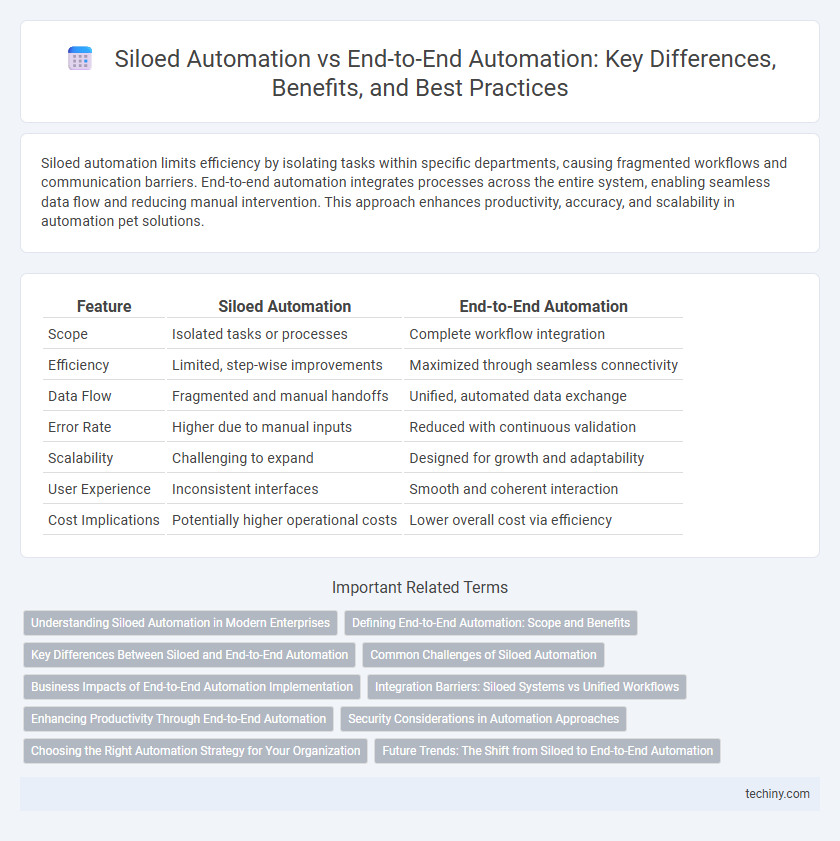Siloed automation limits efficiency by isolating tasks within specific departments, causing fragmented workflows and communication barriers. End-to-end automation integrates processes across the entire system, enabling seamless data flow and reducing manual intervention. This approach enhances productivity, accuracy, and scalability in automation pet solutions.
Table of Comparison
| Feature | Siloed Automation | End-to-End Automation |
|---|---|---|
| Scope | Isolated tasks or processes | Complete workflow integration |
| Efficiency | Limited, step-wise improvements | Maximized through seamless connectivity |
| Data Flow | Fragmented and manual handoffs | Unified, automated data exchange |
| Error Rate | Higher due to manual inputs | Reduced with continuous validation |
| Scalability | Challenging to expand | Designed for growth and adaptability |
| User Experience | Inconsistent interfaces | Smooth and coherent interaction |
| Cost Implications | Potentially higher operational costs | Lower overall cost via efficiency |
Understanding Siloed Automation in Modern Enterprises
Siloed automation in modern enterprises refers to isolated automation processes confined within specific departments or functions, limiting data flow and workflow integration. This fragmentation often results in inefficiencies, duplicated efforts, and lack of unified visibility across the organization. Understanding the constraints of siloed automation is crucial for transitioning toward end-to-end automation, which enables seamless, cross-functional operations and improved overall productivity.
Defining End-to-End Automation: Scope and Benefits
End-to-end automation encompasses the entire workflow, integrating multiple processes and systems to deliver seamless, continuous operations without manual intervention. This comprehensive scope reduces errors, increases efficiency, and enhances scalability by connecting disparate automation silos into a unified ecosystem. Benefits include improved data accuracy, faster processing times, and greater agility in adapting to changing business requirements.
Key Differences Between Siloed and End-to-End Automation
Siloed automation focuses on automating individual tasks or processes in isolation, often resulting in fragmented workflows and limited visibility across the enterprise. In contrast, end-to-end automation integrates multiple processes across systems, enabling seamless data flow, enhanced efficiency, and comprehensive analytics. Key differences include scope of coverage, with siloed automation targeting specific functions, while end-to-end automation addresses complete business processes, driving higher scalability and reduced operational bottlenecks.
Common Challenges of Siloed Automation
Siloed automation often leads to fragmented workflows and limited visibility across business processes, resulting in data inconsistencies and operational inefficiencies. This isolated approach hampers scalability and creates bottlenecks due to the lack of integration with other systems, increasing maintenance complexity. Organizations face difficulties in maintaining compliance and achieving real-time insights, undermining overall automation value.
Business Impacts of End-to-End Automation Implementation
End-to-end automation streamlines workflows by integrating disparate systems, resulting in enhanced operational efficiency and reduced manual errors. It fosters real-time data visibility, enabling more informed decision-making and faster response times. This comprehensive approach drives significant cost savings, improves customer satisfaction, and accelerates time-to-market for new products and services.
Integration Barriers: Siloed Systems vs Unified Workflows
Siloed automation creates integration barriers by isolating processes within individual systems, leading to data fragmentation and inefficient handoffs that hinder overall operational performance. Unified workflows in end-to-end automation break down these silos by enabling seamless data flow and synchronized task execution across platforms, enhancing collaboration and reducing errors. This holistic integration supports real-time analytics and scalable automation strategies, driving greater organizational agility and productivity.
Enhancing Productivity Through End-to-End Automation
End-to-end automation integrates workflows across multiple systems, eliminating isolated silos and streamlining processes for greater efficiency. By connecting disparate tools and data sources, it reduces manual handoffs, minimizing errors and accelerating task completion. This holistic approach significantly enhances productivity by enabling seamless, continuous operations and real-time visibility into the entire automation lifecycle.
Security Considerations in Automation Approaches
Siloed automation often exposes security vulnerabilities due to fragmented oversight, increasing risks of unauthorized access and data leaks within isolated systems. End-to-end automation centralizes control, facilitating comprehensive security protocols and real-time monitoring to detect and mitigate threats across the entire workflow. Integrating robust encryption, identity management, and continuous compliance checks strengthens the security posture in automated environments.
Choosing the Right Automation Strategy for Your Organization
Choosing the right automation strategy involves evaluating whether siloed automation suits isolated tasks or if end-to-end automation better integrates workflows across departments. Siloed automation often results in fragmented processes and limited scalability, while end-to-end automation enhances efficiency by connecting multiple systems for seamless data flow and reduced manual intervention. Organizations targeting long-term agility and comprehensive process optimization should prioritize end-to-end automation strategies aligned with their digital transformation goals.
Future Trends: The Shift from Siloed to End-to-End Automation
Future trends in automation emphasize the shift from siloed automation, where isolated tasks are automated independently, to end-to-end automation that integrates entire workflows for seamless process efficiency. End-to-end automation leverages AI, machine learning, and advanced analytics to connect disparate systems, enabling real-time data flow and enhanced decision-making across the enterprise. This transformation reduces operational bottlenecks, accelerates business agility, and supports scalable digital transformation initiatives.
Siloed Automation vs End-to-end Automation Infographic

 techiny.com
techiny.com